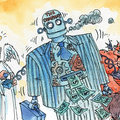Should the Fed worry more about rising prices or weak growth?
WITH skinny trousers and Mary Quant dresses, fashionable Americans are taking their cues from the 1960s this spring. For financial markets and central bankers the retro theme comes from a different, less pleasant, decade. With growth slow yet inflation stubborn, America is facing a weak echo of that 1970s scourge—stagflation.
The economy grew by only 1.3% at an annual rate in the first three months of the year, whereas the overall GDP deflator—the broadest output-based measure of price pressure—rose at an annual rate of 4%. The deflator for “core” personal consumption expenditures (PCE), which excludes fuel and food, rose more modestly in the first quarter. But this favourite inflation yardstick of the Federal Reserve was still outside its comfort zone.
By the standards of the 1970s, when inflation was in double digits and unemployment not far behind, today's plight is hardly grave. Jobs are plentiful and price pressures, by historical standards, are low. But for today's central bankers, determined to maintain their credibility as inflation-fighters, it is distressing all the same. Despite a year of sluggish growth, America's underlying prices have been rising uncomfortably fast.
So far the central bankers have talked tough and done little. They have kept short-term interest rates steady at 5.25% since June, but have made clear that inflation is what worries them most. That bias is likely to be repeated at the Fed's next policy-setting meeting on May 9th.
Less obvious is what will happen over the next few months. Financial markets reckon the Fed will eventually fear recession more than inflation. The price of Fed and eurodollar futures suggests that the central bankers are very likely to cut rates by at least a quarter point in the second half of the year, with more loosening likely early in 2008.
That may not mean much. Financial markets have consistently overestimated the central bank's willingness to cut rates in recent months. Look at the sources of inflationary pressure and it is hard to see the Fed dropping its guard. Energy costs have risen sharply (petrol prices are up 80 cents a gallon or more than 30% in the past three months). The dollar is down, hitting a record low of 1.366 against the euro on April 30th. Virtually every measure of wage growth has been accelerating, although increases in productivity have been lacklustre.
Traditional danger signals, in short, all point one way. But they may be becoming less important. The statistical evidence suggests that, thanks to the central bankers' credibility as inflation fighters, America's underlying rate of price increases has become less vulnerable to transitory pressures, such as rising energy or food prices. The relation between unemployment and inflation has also weakened. And with profit margins fat, America's firms have room to absorb higher wage costs.
What matters most, as several Fed governors have pointed out in recent weeks, are people's expectations of future inflation, which in turn depend on their faith in the central bankers. Provided people believe in the Fed's determination to keep inflation low, inflation expectations will stay low. That seems to have been the case. Most gauges of long-run inflation expectations, such as surveys of professional forecasters, have been relatively stable, at 2% or just above, for the Fed's preferred inflation gauge. However, one measure—the Michigan consumer survey—has jumped a fair bit in April, thanks to higher fuel costs.
 | |
Despite the underlying inflation risks, a statistical quirk may push core inflation down in the coming months. Housing costs make up a large chunk of America's inflation basket (almost 40% of the core consumer-price index and 20% of the Fed's preferred measure). Since the statisticians lack a direct measure of housing costs for homeowners, they impute a cost based on rents. As the property bubble burst in 2006, more people decided to rent houses rather than buy. That pushed up the imputed cost of housing. Now the supply of rental properties is rising as beleaguered owners try to rent out their unsold flats. With vacancy rates high, rents may slow. March's core PCE index was flat, bringing the 12-month increase down to 2.1%, barely above the Fed's informal limit. It may fall further in the coming months. Exclude rents and it looks even better (see chart).
Less clear is whether core inflation at 2% would calm the central bankers enough for them to cut interest rates. One problem is that Fed officials have not agreed on what their optimal inflation rate is or how quickly they would like to reach it.
Some of the board's more hawkish members would probably prefer core consumer inflation to be well within the central bank's comfort zone of 1-2%. Others might be content with something closer to 2%. One governor, Frederic Mishkin, recently made clear that getting inflation below 2% would demand a reduction in inflation expectations that could be “difficult and time-consuming to bring about”.
Much will depend on just how weak the economy continues to be. So far, sub-par growth has not brought the higher unemployment that the central bankers expected and want. And their official forecast is that GDP growth will strengthen in the second half of the year.
The most recent evidence is mixed. Durable-goods orders suggest investment spending may be recovering from its recent funk. A widely watched index from the Institute for Supply Management showed manufacturing was unexpectedly strong in April. With a weaker dollar and perky growth in the rest of the world, exports are likely to grow fast.
But news from the housing market is getting ever gloomier. An index of pending home sales fell unexpectedly to its lowest level in four years in March. And, hit by higher fuel costs as well as falling house prices, consumers may finally be flagging. Americans cut their spending by 0.2% in real terms in March.
Add these mixed signals on growth to the uncertainties about inflation and the chances are that the Fed will simply do nothing for a good while yet. Unlike in fashion, in central banking the underlying trend can take a while to spot.




